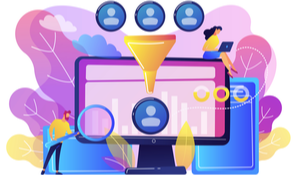The growing technological capabilities to capture, track and measure talent-related data have presented tremendous opportunities to better combine the scientific and the human aspect of HR to build a workforce that is efficient and high performing. In fact, a report by Oracle revealed that HR uses analytics more than any other vertical, outdoing even finance.
Predictive analytics has taken the raw potential of reams of data and turns it into predictive insights which are actionable across nearly every aspect of HR – from talent acquisition, performance and productivity to upskilling. Here are 5 of the top benefits of using predictive analytics in the HR function:
More precise hiring of best fit candidates.
As companies continue to struggle with recruitment in an historically low unemployment market, the need to hire talent that is not only qualified for a job but is a good cultural fit has grown more vital. While cultural fit has historically been difficult to quantify, using pre-hire assessment data and analytics has given recruiters and hiring managers the ability to scientifically match which candidates will fit into the organization’s culture and perform successfully in the job.
Even beyond screening for best-fit, analytics are also making it easier to conduct even routine aspects of candidate recruitment, such as background checks, and create algorithms from unemployment rates, growth indices, GDP, turnover numbers and others to evaluate future HR needs.

Create high performing, productive workforces.
With the pace of business at warp speed in today’s environment, it is crucial to ensure every employee is productive and performing at their best. Predictive analytics are helping HR boost productivity levels by maintaining a laser focus on workers’ performance, progress and developmental needs. Using data from performance assessments and tracking, HR professionals can better determine who is outperforming their peers, who may have potential to improve with specific skill development, or who is best positioned to take on a more senior leadership role.
Drive higher employee engagement.
With turnover plaguing nearly every organization today, the need to keep employees satisfied and engaged can’t be overstated. The good news is HR analytics has made the ability to track and measure engagement easier. For example, tools can now track satisfaction and engagement levels while leveraging analytics to understand specific aspects such as, morale levels, motivational needs and connection to the company’s culture and mission.
Armed with this information, HR professionals can create and implement more targeted employee experience programs and redirect communications to employees to address specific engagement disconnects in real time.
Boost skill development.
With looming skills gaps and digital advancements within many key professions and industries, HR leaders are focusing more and more on upskilling and development programs for its workforce. Today, HR leaders can weave analytics into workforce development and learning programs to make the experience more customized, personal and contextual. Powerful data and analytics allow HR to better predict gaps and plug them with targeted upskilling or development opportunities, avoiding long lags in performance.
For example, talent assessment data and analytics can be used to select, adapt or steer a certain training module based on unique employee preferences and needs. This data-centric perspective on learning development allows HR to tailor curriculum development ideas and address the most critical needs.
Improve retention levels of top-tier talent.
HR leaders are all too familiar with the high costs and resources associated with recruiting, selecting, onboarding and training workers. Therefore, curbing turnover, particularly among high-performing talent, is critical. Predictive analytics can dramatically improve attrition rates by measuring historical data to better predict turnover before it happens.
HR leaders can now combine machine learning algorithms with employee data to identify specific reasons that contribute to employee turnover. By analyzing data for each team member, such as job title, tenure, employee performance scores, or exit interview content, HR can now identify high performers with high flight risk.
Predictive HR Analytics are the Future.
Having moved beyond simply capturing and measuring data, HR now has the capabilities to leverage this information to inform and predict key HR outcomes. As measuring unquantifiable data continues to become much easier, predictive HR analytics has the potential to significantly alter the way organizations recruit and maximize their workforce.
For more insight into predictive HR analytic tools and methods, check out these resources:
· Why Predictive Analytics is a Game Changer for Human Capital
· How Recruiters Can Use Predictive Analytics to Improve Hiring
· HR Analytics: Everything You Need to Know

